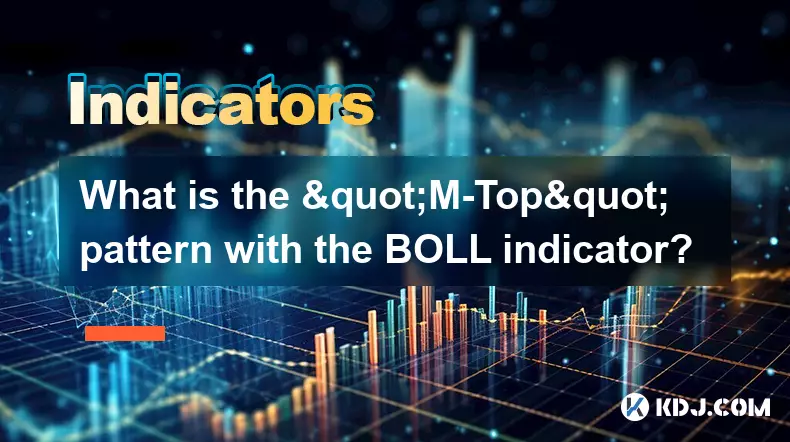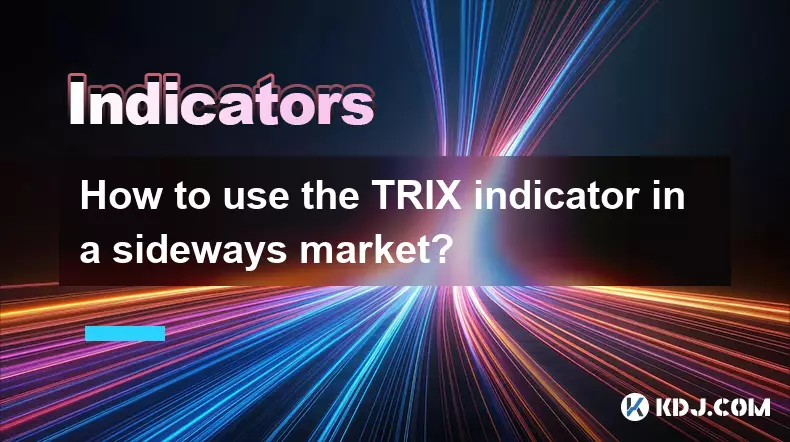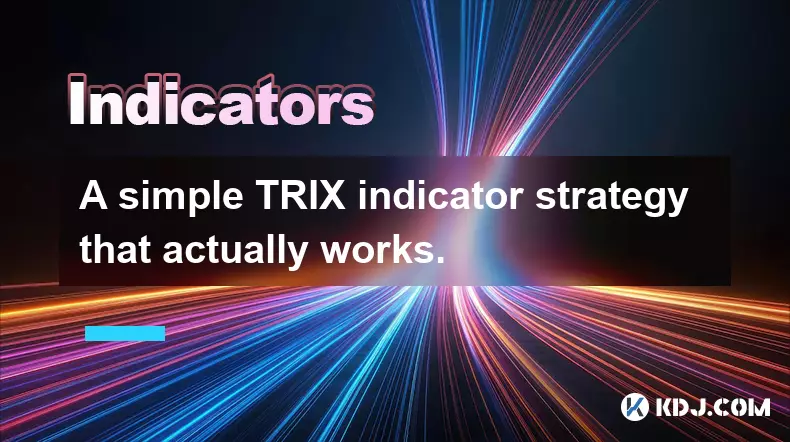-
 bitcoin
bitcoin $106680.127705 USD
0.67% -
 ethereum
ethereum $3615.722480 USD
-0.65% -
 tether
tether $0.999925 USD
-0.04% -
 xrp
xrp $2.550072 USD
5.91% -
 bnb
bnb $1002.572269 USD
-0.90% -
 solana
solana $168.746669 USD
1.08% -
 usd-coin
usd-coin $0.999832 USD
-0.03% -
 tron
tron $0.297244 USD
1.97% -
 dogecoin
dogecoin $0.182965 USD
0.71% -
 cardano
cardano $0.600432 USD
2.56% -
 hyperliquid
hyperliquid $41.439691 USD
-1.57% -
 chainlink
chainlink $16.548399 USD
2.40% -
 bitcoin-cash
bitcoin-cash $524.993680 USD
3.45% -
 stellar
stellar $0.302259 USD
4.10% -
 zcash
zcash $539.994871 USD
-16.31%
What is the "M-Top" pattern with the BOLL indicator?
The M-Top pattern, resembling an "M", signals a bearish reversal when price forms two peaks near the Bollinger Upper Band, fails to break higher, and closes below the middle band with increasing volume.
Nov 06, 2025 at 11:45 am

M-Top Pattern: Definition and Identification
1. The M-Top pattern is a bearish reversal formation commonly observed in cryptocurrency price charts. It derives its name from the visual resemblance to the letter 'M', characterized by two distinct peaks with a trough in between. This structure signals a potential shift from an uptrend to a downtrend, especially when confirmed with volume and technical indicators like the Bollinger Bands (BOLL).
2. Traders identify the M-Top when price reaches a high, pulls back slightly, then rallies again to a similar or slightly lower peak before dropping sharply. The neckline forms at the lowest point of the pullback between the two peaks. A decisive break below this neckline often confirms the pattern.
3. In the context of the BOLL indicator, the upper band acts as dynamic resistance. When both peaks occur near or touch the upper Bollinger Band, it suggests overbought conditions and waning bullish momentum. Repeated failure to sustain prices above the upper band reinforces the bearish signal.
4. The middle band, typically a 20-period simple moving average, may start to flatten or turn downward during the second peak, indicating weakening trend strength. Simultaneously, narrowing bandwidth—known as the 'squeeze'—prior to the second peak can foreshadow increased volatility upon breakdown.
5. Volume analysis plays a critical role. Ideally, volume should be higher on the first peak and diminish during the retest, showing lack of conviction among buyers. A surge in volume on the breakdown below the neckline strengthens the validity of the reversal.
Integration of BOLL Indicator in M-Top Confirmation
1. The Bollinger Bands consist of three lines: the upper band, the middle band (SMA), and the lower band. During an M-Top formation, the interaction between price and these bands provides valuable context. When price touches the upper band twice and fails to close above it on the second attempt, it reflects resistance pressure.
2. A key confirmation occurs when price closes below the middle Bollinger Band after the second peak, suggesting that short-term momentum has shifted bearish. This move often coincides with the breakdown of the neckline and increases confidence in the pattern’s reliability.
3. Bandwidth contraction before the second peak indicates reduced volatility, which frequently precedes a strong directional move. If the subsequent price drop breaks through the lower band, it signals a powerful bearish impulse, typical in volatile markets like Bitcoin or altcoin trading pairs.
4. Traders monitor standard deviation settings (usually set at 2) to assess how extreme the price move is relative to recent averages. A sharp drop penetrating the lower band after forming the right shoulder of the M-Top shows accelerated selling pressure.
5. The BOLL indicator alone does not confirm reversals but enhances the M-Top signal when aligned with price action. Combining it with RSI divergence—where RSI makes a lower high while price makes a higher or equal high—adds further confluence to the bearish outlook.
Trading Strategies Based on M-Top and BOLL Signals
1. Entry points are typically triggered once price closes below the neckline with supporting volume. Conservative traders wait for a retest of the broken neckline from below, now acting as resistance, before initiating short positions.
2. Stop-loss placement is usually set just above the second peak to account for false breakouts, minimizing risk if the uptrend resumes unexpectedly. Given the volatility in crypto markets, allowing some buffer helps avoid premature exits due to price spikes.
3. Profit targets are measured by projecting the vertical distance from the highest peak to the neckline downward from the breakdown point. For example, if the peak is $30,000 and the neckline sits at $27,000, a target would be set at $24,000.
4. Some traders use the lower Bollinger Band as a dynamic profit-taking zone, especially if price approaches it rapidly after breakdown. Others trail their stops using the middle band as a guide during extended downtrends.
5. Scalpers may act earlier, shorting near the second peak when price rejects the upper Bollinger Band with bearish candlestick patterns like shooting stars or bearish engulfing bars, even before neckline breach.
Frequently Asked Questions
What timeframes are most effective for spotting the M-Top pattern with BOLL?The daily and 4-hour charts are widely used for identifying reliable M-Top formations in cryptocurrency trading. These timeframes reduce market noise compared to lower intervals and provide clearer signals when combined with Bollinger Bands.
Can the M-Top appear in sideways markets?Yes, though less common. In ranging markets, the M-Top may form near resistance levels where price tests the upper boundary multiple times. When accompanied by BOLL tightening and failed upper band breaks, it can still indicate impending downside movement.
How does the M-Top differ from the Double Top pattern?The M-Top is essentially a more detailed version of the Double Top, emphasizing the shape, intermediate pullback, and often incorporating volume and indicator analysis. While both signal bearish reversals, the M-Top framework includes more nuance in confirmation criteria, especially with tools like BOLL.
Disclaimer:info@kdj.com
The information provided is not trading advice. kdj.com does not assume any responsibility for any investments made based on the information provided in this article. Cryptocurrencies are highly volatile and it is highly recommended that you invest with caution after thorough research!
If you believe that the content used on this website infringes your copyright, please contact us immediately (info@kdj.com) and we will delete it promptly.
- Startale, Soneium Blockchain, and the Super App Revolution: What's the Buzz?
- 2025-11-11 22:55:01
- Cardano DeFi: Stablecoin Surge & Ecosystem Evolution in Late 2025
- 2025-11-11 23:00:02
- Monad, Launch, Tokenomics: Navigating the Hype and Headlines
- 2025-11-11 23:30:00
- Sony's Soneium Network: A Gas-Free App Revolutionizing Web3 Onboarding
- 2025-11-11 22:50:02
- Bitcoin's Recovery: Buyer Fatigue or Just a Mid-Rally Nap?
- 2025-11-12 00:00:02
- Decoding Crypto Trends: From Bitcoin's Treasury Battles to Ethereum's Upgrade Hype - What's Next?
- 2025-11-12 00:00:02
Related knowledge

What's the best way to learn the TRIX indicator?
Nov 10,2025 at 12:39pm
Understanding the Basics of the TRIX Indicator1. The TRIX (Triple Exponential Average) indicator is a momentum oscillator designed to filter out short...

How do professional traders use the TRIX indicator?
Nov 06,2025 at 04:40pm
Understanding the TRIX Indicator in Crypto TradingThe TRIX (Triple Exponential Average) indicator is a momentum oscillator used by professional trader...

Can I use the TRIX indicator on my mobile trading app?
Nov 07,2025 at 07:40pm
The TRIX indicator, a momentum oscillator designed to filter out short-term fluctuations and highlight long-term trends, has become increasingly popul...

How to use the TRIX indicator in a sideways market?
Nov 10,2025 at 03:00pm
Bitcoin’s Role in Decentralized Finance Evolution1. Bitcoin remains the cornerstone of decentralized finance, serving as both a store of value and a b...

How to code a simple TRIX indicator script in Pine Script?
Nov 07,2025 at 06:20am
How to Code a Simple TRIX Indicator in Pine Script The TRIX (Triple Exponential Moving Average) indicator is widely used in cryptocurrency trading to ...

A simple TRIX indicator strategy that actually works.
Nov 08,2025 at 05:39pm
Understanding the TRIX Indicator in Crypto Trading1. The TRIX (Triple Exponential Average) indicator is a momentum oscillator designed to filter out s...

What's the best way to learn the TRIX indicator?
Nov 10,2025 at 12:39pm
Understanding the Basics of the TRIX Indicator1. The TRIX (Triple Exponential Average) indicator is a momentum oscillator designed to filter out short...

How do professional traders use the TRIX indicator?
Nov 06,2025 at 04:40pm
Understanding the TRIX Indicator in Crypto TradingThe TRIX (Triple Exponential Average) indicator is a momentum oscillator used by professional trader...

Can I use the TRIX indicator on my mobile trading app?
Nov 07,2025 at 07:40pm
The TRIX indicator, a momentum oscillator designed to filter out short-term fluctuations and highlight long-term trends, has become increasingly popul...

How to use the TRIX indicator in a sideways market?
Nov 10,2025 at 03:00pm
Bitcoin’s Role in Decentralized Finance Evolution1. Bitcoin remains the cornerstone of decentralized finance, serving as both a store of value and a b...

How to code a simple TRIX indicator script in Pine Script?
Nov 07,2025 at 06:20am
How to Code a Simple TRIX Indicator in Pine Script The TRIX (Triple Exponential Moving Average) indicator is widely used in cryptocurrency trading to ...

A simple TRIX indicator strategy that actually works.
Nov 08,2025 at 05:39pm
Understanding the TRIX Indicator in Crypto Trading1. The TRIX (Triple Exponential Average) indicator is a momentum oscillator designed to filter out s...
See all articles









































































